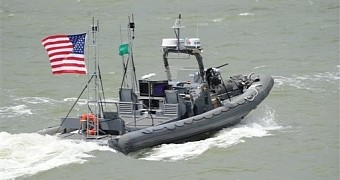Robots capable of working independently from man, or at least partially independently, have been the subject of our imagination for a long time. The US navy is ready to use such things already, even if they aren't quite as humanoid as we might expect.
This could be the foundation for safer seas and oceans, or an excuse for more off-shore “accidents” now that human casualty risks have been brought to such low levels.
Testing another nation’s defenses and vigilance can happen with much more impunity if you don't have to worry about someone seeking retribution for loss of their soldiers' lives. But perhaps we are looking at things through a lens that is a bit too pessimistic.
Anyway, the US Navy has successfully tested robotic patrol boats, a sort of equivalent for the Air Force's unmanned aerial drones, if you want to look at them that way.
The robotic patrol vessels are meant to guard
That's the official stance anyway. The US Navy intends for them to escort warships through sensitive sea lanes, which is another term for contested waters.
Sure, the seas and oceans are, officially, pretty clearly divided on a map, but there are so-called International waters, as well as areas where it's easy to drift a bit too far into another sovereign nation's territory.
The demo didn't happen out at sea though. Instead, the unmanned patrol boats guarded a larger ship in a simulated scenario along the James River in Virginia. There are thirteen robotic patrol boats in total.
According to the results released by the Office of Naval Research, a suspicious vessel was detected eventually. At that point, five of the escort craft continued to guard the ship, while the other eight went and investigated the anomaly.
While the eight swarmed the so-called target, the other five safely accompanied the main ship through the area until they were clear of “dangers.”
The specs of the patrol vessels
Each robotic boat, dubbed rigid hulled inflatable boats, measures 11 meters / 12 yards and are remotely controlled via a robotic system.
Normally, each boat needs four sailors, but with the new technology it's enough for a single sailor to remotely pilot 20 of them from the safety of the mother ship. The sailor can guide the boats into a variety of maneuvers and even order them to fire if a threat is detected.
If communications break off though, the vessel goes dead in the water. Also, if the boat suffers some sort of malfunctions, there are two separate comm links that can be used to issue a shutdown signal.
These were the failsafes in place during the demonstration of course. In actual engagements, the automated or comm-delivered responses to such instances can be far less friendly.
The technology is called CARACaS, short for Control Architecture for Robotic Agent Command and Sensing, and costs thousands of dollars/euro to add to existing craft, instead of the millions it would take to create totally new patrol craft.
Now it just remains to be seen if people wary of the spread of armed robots and get up in arms over this. At the very least, some rules will be set in place for the R&D and implementation of CARACaS.

 14 DAY TRIAL //
14 DAY TRIAL //